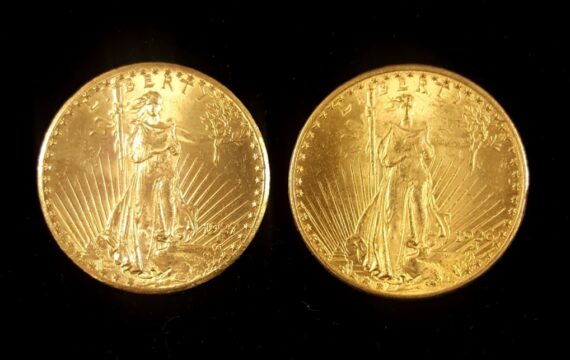
Take a look at the Currency below. The note on the top left was issued in Armenia in 1922. The one below that is a US Series 1901 “Bison” $10 Note. The third note is a Colonial Piece from around thetime of the American Revolution. Can you spot the anti-Counterfeiting devices of each?
You might be wondering what these three pieces of currency have in common? They all demonstrate some technology at work to make it harder for counterfeits to be passed off as real bills. I am going to talk about what some of these things are and how each note is a snapshot of the technology used at the time so people could spot fake notes.
Ok, so half the fun of being a sovereign nation is that you get to print up your own money, and as such, get to decide on what you want to put on that piece of linen (money is not paper). As governments figured out from coinage, these “mini-patriotic posters” printed in plenty, could not only be used as a means of exchange, there was a sense of national pride in the piece as well. Back in the day for many people “pictures” on the currency were important since many people were illiterate. It was a great way to remind the populace who was “Large and In Charge.” I make this point because I am always very proud of the fact that in modern Armenia, we put pictures of Writers and Poets on currency, not Kings or Dead Presidents. I just love that message. I guess a culture that old figured out what the higher aspirations of a populace should be. Either way, it is all just a platform to win the hearts and minds of a populace and convince them the money is as legitimate as who is on it. Not much different then hiring a celebrity to sell Reverse Mortgages on TV. But I may be getting distracted.
Here is the thing. ALL MONEY prior to Bitcoin, has always been created at some national level, and as such, required that “Nation” to protect the integrity of their currency. So, this is all a good thing as long as no one else can easily print it up as well. Governments use the amount of money in circulation as a way (good or bad) to administer fiscal policy. It is a tough game to figure out how much to print. Print too much, and it can fuel inflation (making things more expensive), or print too little and you may wind up with deflation (creating a drag on buying). Why would you buy anything if you knew it would be cheaper next year? Print the right amount and the economy can grow and everyone is the better for it.
At least that’s the theory.
While deflation is possible, and has occurred many times in history, human and Government nature is to err on the over-printing side of things. When you realize that it only takes a few cents worth of supplies and turn a piece of linen into a $20 bill, you can somewhat understand the allure. This was such a concern in the days of old that they used to print the following right on the note:
Now I will not go into where I think that falls on the national moral compass, but I will say it suffices that it the threat of counterfeit currency to a nation is bad enough that they insisted on killing ANYONE who would do it. So how do we keep the competition out of the “make a $20.00 Bill for 3.5 cents” business? After all, that is a markup that is VERY hard to resist. In Short, the legitimate issuer must print the note in such a way as to make it difficult to copy. How do they do that?
Let’s go back to Armenia in 1921. As a result of the end of WWI, and for the first time in since Levon the 5th in later 1300’s, Armenia had once again become a Sovereign Nation. You can imagine that what you see above is the result of some very quick moving economic developments. It takes a lot of money to restart a nation, and explains a lot about how this note looks, its (hyper-inflation) denomination, and hand written look. For the most part, what you are looking at, (except for a nation holding on by their fingernails), are some anti-counterfeiting devices.
What color ink do you suppose was the hardest to get in Post WWI Armenia, and how many places could you do multi-color off-set printing?
Even if you did manage to get an offset printer, you still had to have one that would be good enough to align each pass well enough, and would but the right amount of ink (resolution) to a point where lines don’t run, etc. The fact that you can see lines in the bottom half of the numbers and not just black splotches means a higher quality printing process.
And finally, some hard tech. An actual mechanical numbering machine that pressed this number on in yet another machine pass.
Meanwhile, 20 years before that, the United States of America was hot and heavy into a national expansion that happened so fast and with such unbridled greed, we had perfected the concept of the robber-barron in a no holds barred race to “own it all.” That expansion came at great cost to the indigenous natives of the United States and it was just at this time the Nation’s conscious reflected this regret in an Ode to earlier American life in this wonderful series. Here we have a note that breaks the mold of Dead Presidents and Leaders, to “National Explorers” reflecting the treasures of the great west. When this note was printed, there were only a few thousand Bison left out of what was projected to be 20 to 50 million before the kill-off. This is a great note in our History. It is a reflection of the time when the US had finished looking out and was now beginning to look within to define what kind of nation we wanted to continue to be, or not to be.
But back to Anti-Counterfeiting.
By now, the US Government had been printing money for over 40 years. We were a nation of machines, and this kind of stuff was the height of mechanical engineering. The US was printing money by the boatload, literally. The US was soon to learn a few major economic lessons, but for now the nation and even many other countries were fast relying on the “greenback” to facilitate the world-wide thirst for goods and services. We got so good at anti-counterfeiting, we no longer had to threaten people with death, just long jail sentences. But here are some noteworthy features.
Notice the fibers distributed throughout the linen of this note. They were applied in bands from top to bottom. We lose the color under this magnification, but these Red and Blue “Strands” are added to the linen as it is manufactured. Even though the linen that US Currency is printed on only manufactured and purchased from one vendor in the entire United States, the “salting- in” of these colorful fibers was such an expensive technology that it would now take Nation State level resources to be able to pull off this type of manufacturing.
Intaglio Printing was all the rage for high quality off-set printing process. Not to get too technical, but what that means is the above note was made by taking a steel plate with groves in it filled with ink, and then that plate is pressed down into the linen as opposed to just on top of it. This type of printing leapfrogged the resolution of printing. What that means, is that EVERY line, swirl, or letter you see was literally carved into a base metal plate and the limit of how much detail you could get was only limited to how finely you could sculpt the metal plate. Except there is a catch.
The whole metal plate is carved by hand, as a NEGATIVE, using magnification eyewear. These plates could take months to make, and single slip of a carving instrument could ruin all that work! This is probably the most brilliant of all anti-counterfeiting devices. It is called Art.
Imagine how many people would have the number of years of practice to develop the skills required to do such a thing? Answer: Very few. Now if you wanted to counterfeit, you would have to find someone who could make you plates that would make bills this “good.” Clearly leaves me out, and I think you get the point.
There are many more features at work here but we are trying to manage the size of this article.
As if the Death Penalty was not enough, could you spot what else is going on here?
If you are guessing it has something to do with the leaf, you would be correct. If you all think back to your Art class days, you may remember that the “natural form” is harder to duplicate because of its “relative arbitrariness” or “non-symmetrical” form. By pressing the leaf onto a flat surface, they are creating an arbitrary, detailed, high contrast “pattern” that would be very hard to humanly duplicate exactly.
The intelligence of our forefathers never ceases to amaze me. Why we do not listen to them more is beyond me.
Until next time…..
